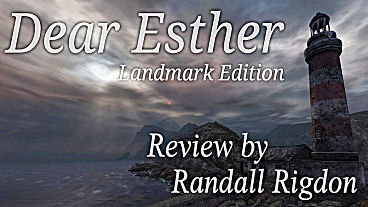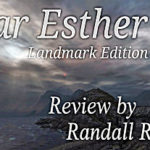
Dear Esther: Landmark Edition Review
[The Landmark Edition] gives me a renewed hope that The Chinese Room will be able to create another title in the future that will be as wonderful as Dear Esther was and still is







Genre: Adventure/Exploration/Walking Simulator
Release date: February 14, 2017
Platform reviewed: PS4
Replaying the initial cult-hit, now “landmark” classic Dear Esther: Landmark Edition, I felt a sense of dread as I thought back on my less-than-stellar review for The Chinese Room’s follow-up, Everybody’s Gone to Rapture.
“Dear Esther is so good,” I thought to myself repeatedly. “I must have played Everybody’s Gone to Rapture with the wrong mindset or something.” This felt especially true considering replaying Dear Esther was a reminder that fundamentally, the two games are not very different.
This attitude, however, was rather quickly killed off while playing Dear Esther: Landmark Edition and listening to the endlessly thoughtful and extremely in-depth commentary tracks along the way which, pretty obviously, reveal The Chinese Room’s sentiment that Dear Esther is still their greatest achievement. They even go so far as to compare the two experiences several times and pretty forwardly discuss what worked and what didn’t..
Now…personally, I initially downloaded Dear Esther on my PS4 without a lot of consideration for the same reason I’ve kept Dear Esther installed on my desktop for so many years: so I could simply load my display with some beautifully tranquil backdrops that I could launch up, explore and jump out of at will. And, thankfully, this remaster more or less delivers on that demand. On my 1080p display, the island looks crisper, cleaner and more gorgeous than ever. The only disappointment in this regard is that it is more a remaster than a remake, so there’s not the huge graphical overhaul that a game of this simplicity from the late 2000s outright deserves. However, everything still holds up beautifully. I did have to increase my brightness a tad, but this wasn’t anything too out of the ordinary.
What really made the purchase worthwhile though, is — again — the commentary. I’m personally quite the fan of game commentary and there have been a few good ones through the years, but Dear Esther is definitely one of the strongest I’ve ever heard, mainly because it does such a great job contextualizing so many things and the game as a whole on so many deeper levels. It’s hard for me to go into great detail about this commentary because to spoil its greatest reveals would take away from the charm of playing this remaster. However, I do want to touch on a couple of things.
For one, the game on paper is about as simple as it can be. Walk along the shore, explore some caverns, listen to some poetic voiceover, maybe see a few hidden details and metaphorical things and then watch the credits.
Now, in my review of Everybody’s Gone to Rapture, I mentioned that Dear Esther was essentially the only game that was truly deserving of the label “walking simulator.” There is a great discussion between the developers about this issue in the game’s commentary.To great intrigue, they discuss their proposed reasoning and the culture around being labeled a walking simulator, what they felt the label meant to each of them and their individual responses to this label.
A lot of the responses from composer Jessica Curry are particularly interesting, seeing as she admits she wasn’t entirely familiar with game culture and design before Dear Esther, whereas now she is much more heavily involved with it. She explains how a lot of the decisions and things she did with Dear Esther was because of her unfamiliarity with game design. Because of this, Curry provides an extremely interesting perspective on how it felt playing Dear Esther as a newcomer to video games, how it felt going through the unique reception to Dear Esther as a newcomer to the industry, and how her newfound experience later played a role in approaching Everybody’s Gone to Rapture.
And that sort of leads into what becomes the fascinating thing about Dear Esther: Landmark Edition: finding out how many of the things that were celebrated about Dear Esther have really simple, easy, and accidental explanations. It’s easy to forget that Dear Esther was initially just a Half Life 2 mod and so much of what’s accomplished in the game is the product of a small team experimenting inside of tiny constraints.
What is also extremely fascinating is how all of the developers essentially have differing interpretations on many different things, and there are a few moments on the commentary where one developer will say to another, “Wow, I never thought of that.” This actually really speaks to the game’s timelessness; how its interpretive nature still resonates to this day thanks to the simplicity of its design and the strength of its narrative delivery.
Most In fact, although I always found the simple walk-alongside-the-beach-journey very satisfying and unique in itself, the developers in the commentary all jump on one of the other developer’s interpretation that the game is a metaphor for a journey through the human body and rebirth. One of the environmental artists even admits this never occurred to him until way after release, which I found astonishing, because once I heard this interpretation myself and listened to all the little tidbits about it, all of the imagery in the environment really did take on another meaning, to the point at which I was like “Wow, there’s just no way this opening in this cavern isn’t symbolism for the resurrection of the character.”
And although that may just sound like some pretentious projecting, at one point one of the developers actually prefaces his interpretation with “at risk of sounding pretentious,” to which Jessica Curry hilariously follows up with “at risk of sounding even more pretentious,” and the two one-up each other with more over-the-top and wild interpretations. However, even though I knew they were half-kidding, their interpretations still felt pretty sound to me and again left me feeling as though I had a new perspective on the game entirely. It definitely came across to me that Dear Esther is such a successful game because of the amount of thought each person brought to his/her contribution, and that those ideas were able to shine through and be felt by the player so strongly due to the simplicity of the “walking simulator” delivery they created. It’s really a testament that when ideas are good enough to stand on their own, that everything around them doesn’t have to be complex..
There is even a moment in the commentary where the developers talk about a tiny photograph on a table that only renders in the environment for the player to find in random playthroughs, that when noticed by the player can greatly change his/her interpretation of the whole story. Now, I’ve played Dear Esther many, many times. And I don’t believe I’ve ever noticed this detail, or maybe it never rendered in my playthroughs. Needless to say, when I saw it, it blew my mind and, after all these years, I have to applaud The Chinese Room for taking such a risk as hiding such a small important detail. Seeing it for the first time so many years made it feel all the more powerful.
I was also surprised to learn what I felt was the most prominent and important narrative sequence in the game was added in over time and was not in the first version. I had never played a version that didn’t have the scene, and by the amount of commentary content offered in that sequence alone, (with one or two naming it as a favorite), it was another extremely insightful moment about Dear Esther to know that such a memorable and withstanding moment was added in as an afterthought.
All-in-all, Dear Esther Landmark Edition, at its core, is a largely unchanged experience. However, the single addition of the new commentary tracks throughout the environment offers an exciting and intriguing change on an already charmingly simple and tranquil experience. I used to love just booting up Dear Esther and going for a walk in its gorgeously crafted environment. But with the new commentary, it felt as though I was finally going on a guided tour of the location I’ve held so dearly through the years. And getting to finally find out who The Chinese Room really is, which is a rather humble team of smart storytellers who can clearly recognize their strengths and their mistakes, gives me a renewed hope that The Chinese Room will be able to create another title in the future that will be as wonderful as Dear Esther was and still is.
Memory: 2 GB RAM

Leave a Reply